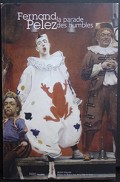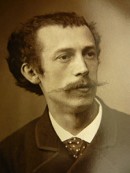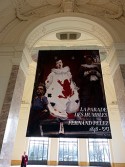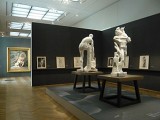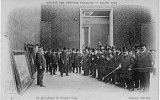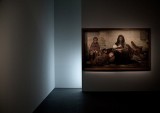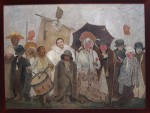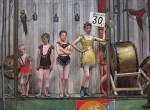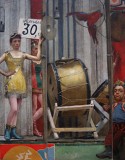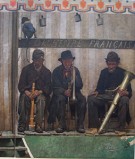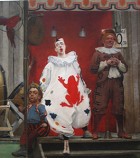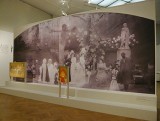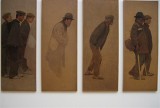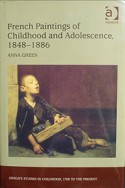The browser will either open the file, download it, or display a dialog.
Fernand Pelez (1848–1913): La parade des humbles
Petit Palais, Musée des Beaux-Arts de la Ville de Paris
September 24, 2009 – January 17, 2010
Catalogue:
Fernand Pelez: La parade des humbles
Edited by Isabelle Collet, essays by Collet, Pierre Rosenberg, Dominique Lobstein, Ségolène Le Men, Alain Bonnet, Jean-Pierre Sanchez; entries by Bonnet, Collet, Guillaume Kazerouni, Le Men, Lobstein, Dominique Morel, Pierre Sérié, Charles Villeneuve de Janti, and Jean-Baptiste Woloch.
Paris: Paris Musées, 2009.
191 pp.; 198 color illustrations, 24 b/w; chronology, list of works exhibited during Pelez's lifetime, genealogical tree, bibliography
37 € ($50, £32.50)
ISBN: 978-2-7596-0100-4
French Paintings of Childhood and Adolescence, 1848–1886
Anna Green
Ashgate Studies in Childhood, 1700 to the Present. Aldershot, UK: Ashgate, 2007
342 pp.; 10 color illustrations, 89 b/w; appendices; bibliography; index
£65.00 (c. $106, 74€)
ISBN: 978-0-7546-5460-5
Translations are by the author.
Early in 1888, two artists in Montmartre completed paintings of Parisian sideshow performers and sent them to separate exhibitions on the Champs-Elysées. Although their studios were only a short distance apart on the boulevard de Clichy – the "little" boulevard, as Van Gogh called the neighborhood – there is no evidence that the tenant at No. 128 bis, Georges Seurat, knew Fernand Pelez at No. 62. Seurat showed Circus Sideshow at the Salon des Indépendants, held from March 22–May 3 in the Pavillon de la Ville de Paris. His Models (Poseuses, 1887–88, Barnes Foundation, Merion, PA) upstaged the other nine works Seurat contributed to the group's fourth exhibition; the smaller night scene at the Cirque Corvi received little or no notice in the press.[1] Pelez, by contrast, sent a single twenty-foot-long painting to the Salon of 1888, which opened on May 1 at the Palais de l'Industrie. Grimaces et misère hung in the last gallery, and the critic for l'Echo de Paris called Pelez a "bad neighbor" for lesser artists in the final room: he had "grabbed all the covers for himself."[2]
Neither artist sold his sideshow canvas during his lifetime, but both paintings now hang in museums. At the Metropolitan Museum in New York, the Seurat is subdued, appearing at a distance as what Jonathan Crary called "a dull rectangle of slate."[3] The Pelez at the Petit Palais, with a heraldic scarlet frog at its epicenter, is more adamant. Grimaces et misère was one of four major works astutely purchased by the City of Paris from the exhibition in Pelez's studio after his death in August 1913.[4] The colossal masterpiece, exiled in the 1930s to hang in the psychiatric hospital Maison-Blanche in Neuilly-sur-Marne, languished in municipal art depots until it was installed at the Bibliothèque Trocadéro in the 1970s. There Robert Rosenblum (1927–2006) discovered the painting, describing it in 1981 as "a virtual double, but in an academic realist vocabulary, of Seurat's circus theme." Rather than puzzling over precedents and formal parallels – yet noting the coincidence of the bare tree to the left of the stage in both works – Rosenblum detected "a common source in Parisian reality."[5] In 1986 the picture returned to the Petit Palais, and in the twenty-first century, the museum's curators lent it to beguile new audiences in Belgium, Canada, and Italy. They then placed Grimaces et misère at the heart of the superb Pelez retrospective that opened in Paris in September 2009.
In his introduction to the catalogue, Pierre Rosenberg, honorary president-director of the Musée du Louvre, cites the essay sent to him by Rosenblum in 1981 as an offprint inscribed "For Pierre, another view of Seurat" (10; fig. 1). The American scholar pleaded in a closing sentence: "When future generations of art historians reconstruct these years, may they not forget Fernand Pelez!"[6] For his first museum retrospective, Isabelle Collet, chief curator at the Petit Palais, and her team gave Pelez new dimensions. Assembling the surviving archival scraps and a scattered photographic documentation, as well as material from museums, churches, private collections, and storage areas, the exhibition reconstructed the artist's career through his works. Pelez was described in 1883 as a seeker, nervous, always in motion: "Interesting physiognomy, one more of those assiduous workers of the new generation on his way to arriving at celebrity by causing a stir" (fig. 2).[7] Despite considerable critical success, his celebrity proved ephemeral, and the next biographical statements came thirty years later as tributes after the artist's death. The curators of this show had many dots to connect, and a first step was to establish his birth date as 1848. Pelez himself had stated it as five years earlier.[8]
At the Petit Palais in 2009, a banner with an apt detail from Grimaces et misère indicated the entrance to the show, serving as a parade, the French word for the traditional "come-on" performed in front of the tent at a traveling fair or circus (fig. 3). Within the exhibition a biographical panel – chiefly a chronology of Salon entries and awards – prepared visitors for the demonstration of Pelez's rigorous academic training. For some three years before he was admitted to the Ecole in 1870, Pelez had prepared himself for the entry competition with private lessons from the painter Félix-Joseph Barrias, the first teacher of Edgar Degas. In the first section of the exhibition ("From the Ecole to the Salon: the Rules of Art"), charcoal-colored panels formed a square enclosure where plaster casts of classical sculpture stood on pedestals, as if awaiting a class (fig. 4).[9] Competition drawings borrowed from the École nationale supérieure des Beaux-Arts (ENSBA) lined the walls.[10]
In a catalogue entry, Alain Bonnet comments on Pelez's three years in the studio of Alexandre Cabanel (39). Bonnet's various contributions, along with the entries and essay by Dominique Lobstein, provide an excellent survey of what it meant to compete in the annual Salon and to serve on juries. Pelez remained loyal to the Société des Artistes Français after the Salon split in 1890 and continued to judge entries until the year before his death (fig. 5). He showed one or two works every year between 1875 and 1880 (except in 1878), and at each of those five Salons the government bought one of his paintings; all five canvases could be retrieved for the 2009 exhibition. The statuesque washerwomen in At the Public Washhouse (Au lavoir, 1880, Musée Malraux, Le Havre), where a bag of bluing is the only touch of color, marked a change in subject; his laundresses earned Pelez a first-class medal in 1880, classifying him as hors concours for the rest of his life. This picture introduced the exhibition's second section ("The Naturalist Woman"). Homeless (Sans Asile, 1883, Petit Palais), an important work in his mature style, won critical praise yet found no purchaser until the City of Paris acquired it from the artist's estate (fig. 6). The government would buy one last Salon painting from Pelez in 1886: Victime (Musée Municipal, Senlis).
Poor children are the subject of the third section of the catalogue ("Small Suffering").[11] After 1881, Pelez became known as the painter of poverty, and he insistently used the word misère in his titles. Critics praised the masterful execution of the horizontal, close-up view of two sleeping boys in A Nest of Poverty (Un Nid de misère, 1887, Petit Palais), described in an entry by Guillaume Kazerouni as "one of the most emblematic examples of la peinture misérabiliste" (74). More characteristic of Pelez were vertical frontal figures of isolated street children, often compared with Murillo; the Little Lemon Vendor (Petit marchand de citrons, c. 1895–97, Musée des Beaux-Arts, Chambéry), painted in six versions and never shown in a Salon, was probably the last of the series. Ségolène Le Men's essay connects the gamins of the academically-trained Pelez with sources in popular culture, especially with the traditional cris de Paris and other depictions of the small trades; she also points to the influence of his father, the illustrator Raymond Pelez (1814–1874), a master of such images (28–33).
Collet observes that Pelez made class antagonism visible in his canvases (67), and reactions in the press, meticulously documented in a catalogue essay by Jean-Pierre Sanchez, suggest that his work in the Salons of the 1880s operated as a "surprising catalyst of the most diametrically opposed political and social energies and forces" (177). There was, therefore, some astonishment in 1884, when Pelez turned to wealthy children for his first and only Salon portrait. Entitled A Family, it depicted ten children of Ferdinand de Lesseps, and several observers mentioned its resemblance to a studio photograph.[12] The following year, describing A Martyr – The Violet Vendor, one critic expressed relief that Pelez had resumed his role as "the painter of the gueux" (vagrants).[13]
La Vachalcade (The Cow-valcade, 1896–1900, Petit Palais) closed the section on needy children (fig. 7). The picture reverses the portrait of the identically groomed de Lesseps clan to show, as Rosenblum might have said, the other side of the societal coin. Shorn heads – a measure to control scabies and tinea, endemic among the destitute – replace the curls of the rich. Of the thirteen young revelers, seven wear full-face masks, and Pierrot gamin stands with a broad smile before a banner labeled Misère and decorated with a dead rat (Le Rat Mort was a well-known café on the place Pigalle). Kazerouni and Le Men (78–85) relate the canvas to the satirical processions in Montmartre in which Pelez participated. The first took place in March 1896, at Mi-Carême (mid-Lent), traditionally celebrated with masked balls and costumes.[14] The word "Vachalcade" derived from manger de la vache enragée, an expression meaning to live in poverty. To mock the revival by entrepreneurs of a Carnival tradition called the Cavalcade of the Boeuf Gras (fatted ox) and to comment on their own precarious existence, the Montmartre artists invented the Cow-valcade. The festivities were planned at les Quat'z'Arts, a cabaret opened in December 1893 by François Trombert in the same building where Pelez lived and worked (fig. 8).[15] One of the organizers of the Vachalcade, Adolphe Willette, published in 1896 the first of two issues of a magazine, La Vache enragée, including a drawing of Pelez with his street kids (fig. 9).[16] For the second (and last) Vachalcade, held in June 1897, Pelez created his only known poster and a float for the procession.[17]
"Sideshows" ("Parades"), the fourth section, evokes the shabby gaiety of street fairs. A number of secondary objects shed light on the setting of Grimaces et misère –Les Saltimbanques: circus posters, Eugène Atget photographs, and – in the exhibition – a trombone (fig. 10). Collet interprets the composition, with its shallow, makeshift stage, as a variation on Degrés des âges (Ages of man), a popular print subject where figures proceed toward the peak of mid-life, ascending from the young on the left and descending to old age on the right (91) (figs. 11, 12, 13, and 14). Pelez shared an interest in itinerant performers with his father: seventeen illustrations of sideshows by the late Raymond Pelez had been captioned and re-issued in the 1870s in a new edition of Les Français peints par eux-mêmes.[18] At the Salon of 1888, the critic Alexandre Georget recognized the theme of Grimaces: "It's the parade: the subjects spread in front of the stall, from the little albino encountered in other canvases of M. Pelez up to Mossieu Bilboquet."[19] Monsieur Bilboquet was the wily leader of a ragbag troupe in Les Saltimbanques, a theatrical comedy hit first performed half a century earlier. Georget readily identified Pelez's man in brown knee breeches: he was a contemporary Bilboquet, still as well known in 1888 as his frail partner Gringalet, the paillasse or clown.[20] Another Salon critic was an expert on sideshows, Hugues Le Roux. He praised Pelez in Le Temps: "I know my foire du Trône [annual fair at the Place de la Nation] inside out. I declare without hesitation that it is very precisely observed."[21]L'Illustration reproduced the painting as a double spread, and Albert Robida gave it a prominent place in a cartoon cover for La Caricature.[22]
Grimaces et misère reappeared with four other Pelez works at the Exposition Universelle of 1889, earning the painter a silver medal; in 1891 he was decorated with the Légion d'honneur. After 1890, however, he shunned the Salon until he had finished another panoramic entry.[23]Humanity! Christ in the Square, displayed at the Salon of 1896, was six feet longer than his sideshow painting and two feet taller. Because the gigantic park scene mysteriously disappeared after the studio exhibition in 1913, the Petit Palais installed a photographic enlargement with two surviving studies in front of the relevant details (fig. 15). In 1896, the Salon critic François Thiébault-Sisson sneered that Humanity! was the result of a good painter being infected by a mania for symbolism:
Figures in a double line are seen grouped on a carefully raked path of the Parc Monceau, edged by a grassy slope as bright as an emerald. To the left are none but haggard creatures with tired eyelids, fevered looks, and dull skins. To the right are comfortable middle-class or rich women, with buxom nurses and rosy, merry children, enjoying their walk in the warm and kindly sunshine.[24]
The picture both invited and deflected interpretation. Thiébault-Sisson called the central Christ figure an anarchist; another reviewer, praising the painting as deserving the medal of honor, said it represented the Savior's anguish that humanity still suffered from mutual hatred.[25]
Reproduced in black and white, the absent Humanity! concluded the fourth section of the Petit Palais retrospective. In fact, the painting itself had signaled a final bow for Pelez's own parade; the artist, disappointed in 1896 by the reception of his allegory, drew the curtains on his public career.[26] Reconstruction of his subsequent work for the exhibition depended on the shadowy realm of photographs and a chronology pieced together from the acquisitions of the municipal collections in 1914.[27] A fifth catalogue section ("The Chapel") examines an ensemble of three paintings, one of which survives: eleven uniformed orphan girls kneeling in prayer (Les Orphelines, c. 1901, Petit Palais). For A Mouthful of Bread (Une Bouchée de pain, 1908), the vanished painting studied in the sixth section, only a single photograph could be traced to display with ten cartoons from the Petit Palais holdings (figs. 16 and 17). Commissioned by the education ministry under Jules Ferry – it was the one government commission Pelez received – the project began in 1881. Originally called Work, renamed Charity, and finally given the title under which it appeared in the 1913 exhibition, the missing painting depicts some twenty men outside an existing soup kitchen called Pain pour tous (Bread for all). The men are seen in profile, from the rear, or as silhouettes, except for a single frontal figure staring at the viewer; Collet points out the resemblance of the silhouetted profiles behind him to the shadow plays of the Montmartre cabarets (119). Profiles, back views, and a frontal nude also dominate the paintings of dancers dating from 1905 to 1913, illustrated in the seventh section ("Mirror Games at the Opera"). These images echo the subject matter of a lost work (La Misère à l'Opéra) exhibited at the Salon of 1885 (129).[28] Tracing the Pelez family was a further challenge, and an eighth section gathers works by the painter's father, uncle, older brother, and cousin. The ninth and final catalogue chapter presents the face of the forgotten artist through self-portraits, portraits, and caricatures.
From what survives of his paintings, a strong thread emerges, described by Pelez himself in 1901 in a plea to the city to preserve his work as a whole; each canvas, he said, was a page in a book in which he had written the story of the Parisian poor (21). The Petit Palais retells that story in the concise, yet sumptuously illustrated catalogue, a handsome record for a thoughtful exhibition. Nearly a century after his death, Collet revived the memory of this compassionate artist, hoping to recall "the complexity of the interactions between academicism and avant-garde animating the Parisian artistic scene on the threshold of modernity" (163). Joséphin Péladan claimed in his tribute to Pelez in 1913 that the painter had asked himself: "Why am I interested above all in those who suffer? I don't know! I've told the story, that's all."[29] In the closing essay for the Petit Palais catalogue, Sanchez raises other relevant questions. Noting that contemporaries of Pelez might have inscribed his work into a genealogy – Bastien-Lepage, Courbet, Murillo, Velasquez – Sanchez asks what are we to do with it today (183–84)? "Into what narratives, into what convincing stories, credible and consistent with pictorial modernity, can the paintings of Pelez be inserted (185)?" How, in other words, does Pelez's work fit into our current practice of art history?
One answer to his query may be found in Anna Green's treatment of Pelez in French Paintings of Childhood and Adolescence, 1848–1886 (55–67; fig. 18).[30] The domain of her study includes his chief canvases of the 1880s; she illustrates seven of them and uses A Martyr – The Violet Vendor for her book jacket. Green examines that painting, as well as Homeless and ANest of Poverty as depictions of misérables in a new, post-Gavroche sense (Victor Hugo's Les Misérables appeared in 1862). She places them somewhere between the "polished poverty" of William Bouguereau's Charity (1865, Birmingham City Museum and Art Gallery) and the oddly unstable "social climate" of Edouard Manet's The Old Musician (1862, National Gallery of Art, Washington, DC), works compared in the paragraphs preceding her Pelez discussion (52–55). In the paintings of Pelez – with narrow color ranges, a drawing technique in the service of social subjects, and a fastidious avoidance of anecdote – Green finds a modern child. It is not only the "directness of appeal, the simplicity of gesture" of his pauper boys – qualities already pointed out by Gabriel Weisberg – but also the ambiguities in his pictures that lead Green to locate Pelez on "a parallel track," sometimes intersecting with modernism (67).[31]
Investigating images of homeless children – abandoned, orphaned, or simply runaways – in her chapter "Working Children: Dangerous Children," Green looks into the problem of child labor and changes in municipal vagrancy laws. She also invokes several observations of Othenin d'Haussonville in his remarkable series published in 1876–79 in Revue des deux mondes.[32] That an Orléanist viscount, then in his mid-thirties, would devote several years to chronicling poor children in the streets of Paris is remarkable in itself. Viscount d'Haussonville had grown up in the elegant rue Saint-Dominique and, as the great-grandson of Madame de Staël, spent his own childhood summers at Coppet on Lake Geneva.[33] Yet in a powerful mélange of institutional history inspired by Maxime du Camp, statistics sifted from official reports, and touching anecdotes picked up in police stations, courtrooms, and refuges, Haussonville instructed himself and his readers on poverty, which he considered, along with ignorance, to be the chief cause of crime.[34] At times, Pelez seems to illustrate the viscount's text, when painting First Cigarette (c. 1880, private collection, Paris), for example, or A Nest of Poverty, exhibited in 1887. Green quotes Haussonville on urchins collecting tobacco from discarded cigar butts and cites his phrase, "the population of pale, nomadic children with watchful eyes" (62).[35] For a new series in 1881, he used a Pelez-like title – "La Misère à Paris" – and provided recent statistics for the poorest arrondissements: Montmartre was not the worst off, but it had an indigent population (those receiving public assistance) of 12,089.[36]
One charm of Green's study is its inclusiveness, within a precisely defined topic, and another is its satisfying rhythm. Alternating chapters deal with working-class boys, then girls, followed by bourgeois girls, then boys. Later chapters on adolescence and on the position of fathers in the nineteenth century include separate analyses of two intriguing works painted at about the same time: Renoir's Young Boy with a Cat (1868–69, Musée d'Orsay, Paris) and Manet's Luncheon in the Studio (1868, Neue Pinakothek, Munich). She treats with equal dignity and insight dozens of lesser-known paintings, such as the Lolita-like Salome Triumphant (present location unknown) by Edouard Toudouze and the luminous girl in Summer Morning (Musée St. Denis, Reims) by Paul-Albert Besnard, both dated 1886.
Green's sprightly text rewards the reader beyond its wealth of examples. Play is central to her quest for painted children, and Baudelaire and Manet remain the benchmarks of modernity as she explores the porous boundaries between seriousness and blague. The views of predecessors enter her arguments without weighing them down. Inspired by art historians T. J. Clark, Michael Fried, Richard Thomson, and many others, she also makes good use of research in other disciplines. Social historian Carolyn Steedman's concept of mignotage, for example – derived from the character of Mignon, the kidnapped child acrobat in Goethe's Wilhelm Meister – enriches Green's section on Frédéric Bazille's Little Italian Street Singer (1866, Musée Fabre, Montpellier), as does John Zucchi's book on child performers.[37] She also relies on the literary scholars Rosemary Lloyd and Christopher Prendergast, particularly in the opening chapter, an essay on childhood, modernity, and Paris in Manet's Music in the Tuileries Gardens (1862, National Gallery, London).[38] Green launches this brilliant overture to her book with a statement on Paris from the passage in Les Misérables introducing the gamin Gavroche: "To paint the child is to paint the town." Hugo's words could have emblazoned a banner for Pelez. As full of surprises as the Petit Palais show, Green's book is another Little Jack Horner pie, rich in plums. She offers fresh views, even of familiar pictures, and – like the Pelez exhibition and catalogue – consistently sidesteps forlorn compartments of avant-garde and ringard.
*Because of copyright restrictions on photographs of Pelez's major works, they can be illustrated here only as links. Search under "pelez" on the websites of the Roger-Viollet Archive (82 large thumbnails) and the RMN Agence Photographique (29 resizable images, including prints from the invaluable François Vizzavona glass negatives of lost works).
Jane Van Nimmen
Independent scholar, Vienna
vannimmen[at]aon.at
[1]Georges Seurat, Circus Sideshow (1887–88, Metropolitan Museum of Art, New York, Bequest of Stephen C. Clark, 1960). See the references in the recent interpretation of Seurat's picture by Albert Boime (1933–2008), Revelation of Modernism: Responses to Cultural Crises in Fin-de-Siècle Painting (Columbia: University of Missouri Press, 2008), chap. 2, with an illustrated discussion of Pelez, 58–59.
[2] Alexandre Georget, "Le Salon de 1888 (deuxième article)," L'Echo de Paris, May 3, 1888. See a full view of Grimaces et misère.
[3] Jonathan Crary, Suspensions of Perception: Attention, Spectacle, and Modern Culture (Cambridge, MA: The MIT Press, 1999), 150.
[4] The city's acquisitions in early 1914, disputed in the press, supplemented a donation by Pelez's sisters of five paintings, ten oil studies, and thirteen drawings.
[5] Robert Rosenblum, "Fernand Pelez, or The Other Side of the Post-Impressionist Coin," in Moshe Barasch and Lucy Freeman Sandler, eds., Art, the Ape of Nature: Studies in Honor of H. W. Janson (New York: H. N. Abrams, 1981), 707–18.
[6] Rosenblum, 716. A notable attempt to recall Pelez from oblivion was made by Gabriel P. Weisberg in Beyond Impressionism: The Naturalist Impulse (New York: Harry N. Abrams, 1992), 88–90.
[7] A[pollo]. M[olochowski]. de Belina, Nos peintres dessinés par eux-mêmes (Paris: E. Bernard, 1883), 169.
[8] Stéphane Guégan notes in his fine online review (October 22, 2009) for The Art Tribune (in English, in French) that Paul Gauguin, also born in 1848, had inherited "the same social, very much Christian, humanitarianism" as Pelez. Other French artists born that year were Jules Bastien-Lepage, Edouard Detaille, Henry Lerolle, Albert Robida, and Edouard Toudouze.
[9] The viewing path of the exhibition corresponded to the nine catalogue sections; the show, however, had eleven rooms. The architect of the installation, Nicolas Hugon, has posted views on his blog.
[10] Three were Pelez works produced during his evening course at the Ecole under Adolphe Yvon; of equal interest were drawings by his fellow students, allowing the exhibition visitor to play judge. Among those available on the ENSBA website is the life drawing that earned Pelez a third-class medal for the competition of June 1870.
[11] The third section's French title "Petit misère" – oddly combining the singular masculine adjective with a feminine noun – was inspired by a painting exhibited in the Salon of 1886 under the title Misère (present location unknown). In the 1913 posthumous exhibition catalogue, the work appeared as Petit [sic] misère (No. 9); see Exposition Pelez [Exposition posthume des oeuvres de Fernand Pelez dans son atelier, 62, bd de Clichy, Paris, 6 déc. 1913–6 janv. 1914]. The Petit Palais curators adopted the 1913 title as a label for Pelez's series of street boys.
[12] The picture could not be located for the Petit Palais exhibition but was shown as a vitrine photograph and reproduced in the catalogue (17). La Presse (unsigned comment, probably Louis Enault), May 6, 1884, listed it among the Salon public's favorites. Even before the exhibition opened, the de Lesseps portrait brought Pelez international publicity. A note in the New York Times, April 13, 1884, announced that the picture had been "painted on the sly as a surprise to the father." For a comparable photograph (c. 1882), see de Lesseps family by Robert Delton, Ministère des affaires étrangères (fonds iconographiques, série G).
[13] Alexandre Georget, "Le Salon de 1885," l'Echo de Paris, May 1, 1885.
[14] Several of the models on the left half of La Vachalcade are familiar from other Pelez works; the Little Lemon Vendor with his oversized derby is there, and the drummer boy has the head of the Violet Vendor from 1885, as Kazerouni points out (82). He also wonders if (and where) Pelez could have seen James Ensor's mask paintings, noting that the first Ensor show in Paris was at the Salon des Cent in December 1898, with a special number of La Plume in his honor.
[15] This building had formerly housed the Café du Tambourin, frequented by Van Gogh in 1887. The Montmartre Vachalcade in 1896 received much comment in the press, including a cover for the Sunday supplement of Le Petit journal, March 22, 1896.
[16] Emile Goudeau, whose novel La Vache Enragée (1885) had inspired the alternative processions and Willette's magazine, founded a more successful publication, Les Quat'z'Arts, in November 1897. Both he and Willette were outspoken nationalists and anti-Semites, an aspect of cabaret culture discussed in Phillip Dennis Cate, "The Social Menagerie of Toulouse-Lautrec's Montmartre," Richard Thomson, Phillip Dennis Cate, and Mary Weaver, eds., Toulouse-Lautrec and Montmartre, exh. cat. (Princeton, NJ: Princeton University Press, 2005), 33–36. See also Venita Datta, "A Bohemian Festival: La Fête de la Vache Enragée," Journal of Contemporary History 28 (April 1993), 195–213.
[17] See Phillip Dennis Cate and Mary Shaw, eds., The Spirit of Montmartre: Cabarets, Humor, and the Avant-Garde, 1875–1905, exh. cat. (New Brunswick, NJ: Jane Voorhees Zimmerli Museum, 1996), 71, fig. 117. Despite rain and wind, the "Temple of the Golden Calf" float designed by Pelez for the second Vachalcade was deemed a triumph in La Presse, June 21, 1897]; the article described problems with stubborn oxen and lauded the public's generosity toward Pelez's street children, the petits miséreux begging spectators along the route to give them two sous.
[18] The reprinted sideshow drawings by Raymond Pelez illustrate Emile de la Bédollière, "Les Banquistes" in Les Français peints par eux-mêmes (Paris: J. Philippart, 1876–78), 3:239–41; the article had originally been published (with a total of nineteen uncaptioned vignettes) in Les Français peints par eux-mêmes: Encyclopédie morale du dix-neuvième siècle. Province (Paris: L. Curmer, 1841), 1:130–41. On his work as the inventor of the Salon caricatural in 1843 and his illustrations for the earlier, ten-volume edition of Les Français (1840–42), see Le Men's catalogue entry on Raymond Pelez (152–54).
[19] Georget, l'Echo de Paris, May 3, 1888.
[20] Théophile Marion Dumersan and Charles Varin, Les Saltimbanques: Comédie-parade en trois actes, mêlée de couplets (Paris: Marchant, 1838); see the cover illustration (in an edition of 1851). Caricaturists immediately deployed the characters for political purposes. In a still-relevant cartoon first published in La Caricature, No. 25, April 25, 1839, Honoré Daumier transposed Bilboquet and Gringalet from provincial Lagny to the Paris stock exchange. An undated watercolor by Draner (pseudonym for Jules Renard) in the BnF suggests why the figure in knee breeches in Grimaces et misère could easily be seen as Bilboquet. Pelez and Seurat were not the last in this tradition; Frederik Hendrik Kaemmerer sent to the Salon of 1896 another Parade, a saucy backstage view, complete with parrot, the indispensable bass drum (la grosse caisse), and an ophicleide (a deep-toned brass wind instrument).
[21] Hugues Le Roux, "Le Jour du Salon," Le Temps, May 1, 1888. The following year, Le Roux published Les Jeux du cirque et la vie foraine (Paris: E. Plon, Nourrit, 1889); see the illustration by Jules Garnier of the Cirque Corvi (71). Otto Brandes, a German critic who viewed Pelez's Salon entries from 1887–90 with increasing alarm, nevertheless observed in the parade "a bone-chilling truth, allowing the artist to avoid caricature. We are gripped by an immeasurable sympathy when we look at these 'disinherited'"; see "Der Pariser Salon 1888," Die Kunst für Alle 3 (1888), 266. Equally moved, André Michel asserted that the picture, painted "with the dryness of a procès-verbal . . . convulses you with a wave of pity." He remarked that it was a sign of the times that there now were "more canvases evoking misère – physiological, social, and moral – than Veronese devoted to celebrating Venetian feasts" ("Le Salon de 1888, III," Gazette des Beaux-Arts 38, 2nd per. [1888], 138–39).
[22]L'Illustration, No. 2379, September 29, 1888, 240, and La Caricature , No. 436, May 5, 1888. Pelez, forty years old, may have hoped for the annual Salon prize, announced at the end of May. The winner, however, was not Pelez, leader of "humanitarian or socialist painting" and the first to exploit the poor and ragged, as he was described by Paul Leprieur, future Louvre curator, then a young critic ("Salon de 1888," L'Artiste 58 [July 1888], 15). The coveted award went instead to Pelez's contemporary Detaille for The Dream (Le Rêve, Musée d'Orsay, Paris), a pointedly Boulangist fantasy of the French army's future glory.
[23] His absence was mourned by the actress turned Salon critic Gustave Haller in 1894: "And Pelez? After his brilliant debuts eclipsing everyone else, his pictures of Misère, so richly successful, and with an insulting opulence of talent, this strange painter . . . Pelez has become completely invisible even with the most advanced telescopes." See Gustave Haller [pseudonym for Wilhelmine-Joséphine Simonin Fould, called Valérie], Le Salon: dix ans de peinture (Paris: Calmann-Lévy, 1902), 1:180.
[24] [François] Thiébault-Sisson, Goupil's Paris Salon of 1896: One Hundred Plates – Photogravures and Etchings. . . by Goupil & Co., translated by Henry Bacon (Paris: Boussod, Valadon, 1896), 14–15. The critic closed his account prophetically: "For a week it was the delight of the public, who found it exhilarating and who reveled in glee before it. This gave way to absolute indifference. When once the Salon is closed, will even a memory remain of this work?"
[25] Thiébault-Sisson, 15; Haller, Le Salon, 1:276–78. In his Petit Palais catalogue entry, Pierre Sérié discusses the missing picture in the context of other turn-of-the-century humanitarian allegories, mentioning Christ on the Mountain (Musée des Augustins, Toulouse), shown in the Salon of 1899 by Edouard Debat-Ponsan, a colleague of Pelez in the Cabanel studio (97–101).
[26] A work entitled Petit Pauvre was among 500 paintings and drawings selected by a jury and sent to the United States to represent the French School at the Louisiana Purchase Exposition in St. Louis in 1904. This was the last known exhibition for Pelez.
[27] The 1913 catalogue Exposition Pelez aided research on the late period. Its preface by Joséphin Péladan was published as "Fernand Pelez (1848–1913)," La Nouvelle Revue 34, 4th ser. (December 15, 1913), 457–62. In his essay "Sâr" Péladan expressed his deep admiration for Pelez, "a kind of Diogenes of sorrow, who didn't need a lantern to find it" (cited by Le Men, 28).
[28] The unlocated Poverty at the Opéra of 1885 contrasted worn street clothes with tutus as two young women put on their costumes backstage. The Dancers (detail of left side), a diptych of 1905–1909 (Petit Palais), is an elaboration on this theme.
[29] Péladan, La Nouvelle Revue, 459.
[30] See the excellent review by Jane Mayo Roos in caa.reviews (June 10, 2009).
[31] Weisberg, Beyond Impressionism, 87.
[32] [Le comte] Othenin d'Haussonville, "L'Enfance à Paris," Revue des deux mondes 17, "I. La criminalité, l'abandon" (October 1, 1876), 481–511; 18, "II. Les Malades" (December 1, 1876), 575–604; 20, "III. Les Hôpitaux d'enfans à Londres . . ." (March 1, 1877), 36–79; 27, "IV. Les Vagabonds" (June 1, 1878), 598–627; "V. La Mendicité, les asiles, les refuges (June 15, 1878), 891–927; 30, [Unnumbered] "Les Enfans pauvres en Angleterre" (November 15, 1878), 241–71; 31, "VI. Les Rendez-vous du crime . . ." (January 15, 1879), 346–74; 32, "VIII. Saint Lazare . . ." (April 15, 1879), 818–53. The series was published as L'Enfance à Paris (Paris: Calmann-Lévy, 1879) and recently as a facsimile reprint (Boston: Elibron Classics, 2002).
[33] Haussonville may have inherited an interest in public welfare from his great-great-grandmother, Suzanne Curchod (wife of Jacques Necker), who founded the Necker Hospital in Paris; Madame Necker was also active in prison reform. His mother, Louise de Broglie – Ingres had painted her portrait (The Vicomtesse d'Haussonville, 1845, The Frick Collection, New York) when Othenin d'Haussonville was a toddler – also had literary interests. In 1874, about the time her son completed a life of Sainte-Beuve and set out to follow the route of impoverished childhood from infancy to prison, the countess published the final volume of her biography of Lord Byron.
[34] Maxime du Camp had originally published Paris, ses organes, ses fonctions et sa vie (Paris: Hachette, 1869–75) as a series in Revue des deux mondes.
[35] Haussonville, L'Enfance, 599–600.
[36] Othenin d'Haussonville, "La Misère à Paris," Revue des deux mondes 45 (June 1, 1881), 826. For another series, the viscount interviewed a disabled paillasse (clown), one of some 5,000 homeless who had been moved into the new prefectural center opened in Nanterre that September (now called Maison de Nanterre); see Othenin d'Haussonville, "Le Combat contre le vice – La répression, I. Les lieux de détention provisoire, le vagabondage, et la mendicité," Revue des deux mondes 84 (December 15, 1887), 823.
[37] Carolyn Steedman, Strange Dislocations: Childhood and the Idea of Human Interiority, 1780–1930 (Cambridge: Harvard University Press, 1995), and John Zucchi, The Little Slaves of the Harp: Italian Street Musicians in Nineteenth-Century Paris, London, and New York (Montreal: McGill-Queens University Press, 1992).
[38] Rosemary Lloyd, The Land of Lost Content: Children and Childhood in Nineteenth-Century French Literature (Oxford: Clarendon Press, 1992) and Christopher Prendergast, Paris and the Nineteenth Century (Oxford: Blackwell, 1992).


